Study on Ni3Al-Based Single Crystal Superalloy Joints Brazed by Vacuum Brazing with Zr-Containing Filler
Abstract
:1. Introduction
2. Experimental Procedures
2.1. Filler Preparation and Test
2.2. Joint Preparation and Test
3. Results
3.1. Characterizations of the Fillers
3.2. Microstructure of the Joint
3.3. Mechanical Properties and Failure Behavior of Joint
4. Discussion
4.1. The Effects of Mo and Zr Content on the Fillers
4.2. The Formation Process of the Joint
4.3. The Influence of Elemental Adjustments on the Joint
4.3.1. ASZ
4.3.2. DAZ and ISZ
4.4. Joint Failure Behavior
5. Conclusions
- (1)
- Thermo-Calc calculations and experimental results suggest that Zr can be utilized as an MPD in the preparation of the filler for brazing Ni3Al-based single crystal superalloys. This results in the formation of robust joints characterized by a combination of γ′, γ, P-TCP, Ni7Zr2, and NiMo phases. The joint can be divided into four regions: BM, ASZ, ISZ, and DAZ.
- (2)
- When adjusting the Zr and Mo contents within appropriate ranges, the filler can completely transform into a liquid state and enter the joint at 1200 °C. Increasing the Zr content in the joint leads to a higher concentration of the Ni7Zr2 phase, which results in an increase in the proportion of the ASZ width. Increasing the Mo content theoretically should increase the diffusion of Ni from the BM to the filler and Al from the filler to the BM. However, the diffusion barrier effect of Mo impedes this phenomenon, leading to a transformation of NiMo phases in the DAZ to P-TCP phases. Nonetheless, a continued increase in Mo content also leads to a higher concentration of the P-TCP phase in the joint.
- (3)
- Ni7Zr2, NiMo, and P-TCP phases are the failure locations of joints. When the Zr content is increased, the rise in the Ni7Zr2 phase within the joint leads to a reduction in the tensile strength. As the Mo content increases, there is a reduction in the NiMo phase, resulting in an increased tensile strength of J4 compared to J1. However, the continuous increase in Mo leads to an increase in the P-TCP phase in the joint, causing a decrease in the tensile strength of J5 compared to J4.
Author Contributions
Funding
Data Availability Statement
Conflicts of Interest
References
- Seyring, M.; Rettenmayr, M. Impact of crystallography at Ni/NiAl interfaces on the nucleation of Ni3Al. Acta Mater. 2021, 208, 116713. [Google Scholar] [CrossRef]
- Wu, J.; Liu, Y.-C.; Li, C.; Xia, X.-C.; Wu, Y.-T.; Li, H.-J.; Wang, H.-P. Microstructural Characterization and Phase Separation Sequences During Solidification of Ni3Al-Based Superalloy. Acta Metall. Sin. Engl. Lett. 2017, 30, 949–956. [Google Scholar] [CrossRef]
- Ghoneim, A.; Ojo, O.A. On the influence of boron-addition on TLP bonding time in a Ni3Al-based intermetallic. Intermetallics 2010, 18, 582–586. [Google Scholar] [CrossRef]
- Yuan, L.; Ren, J.; Xiong, J.; Zhao, W.; Shi, J.; Li, J. Transient liquid phase bonding of Ni3Al based superalloy using Mn–Ni–Cr filler. J. Mater. Res. Technol. 2021, 11, 1583–1593. [Google Scholar] [CrossRef]
- Kong, Z.; Li, S. Effects of temperature and stress on the creep behavior of a Ni3Al base single crystal alloy. Prog. Nat. Sci. 2013, 23, 205–210. [Google Scholar] [CrossRef]
- Ferasat, K.; Swinburne, T.D.; Saidi, P.; Daymond, M.R.; Yao, Z.; Béland, L.K. Interstitialcy-based reordering kinetics of Ni3Al precipitates in irradiated Ni-based super alloys. Materialia 2021, 19, 101180. [Google Scholar] [CrossRef]
- Reed, R.C. The Superalloys Fundamentals and Applications, 1st ed; Cambridge University Press: New York, NY, USA, 2006. [Google Scholar]
- Gao, S.; Zhou, Y.; Li, C.-F.; Cui, J.; Liu, Z.-Q.; Jin, T. In situ investigation on the precipitation of topologically close-packed phase in Ni-base single crystal superalloy. J. Alloys Compd. 2014, 610, 589–593. [Google Scholar] [CrossRef]
- Bennett, R.J.; Krakow, R.; Eggeman, A.S.; Jones, C.N.; Murakami, H.; Rae, C.M.F. On the oxidation behavior of titanium within coated nickel-based superalloys. Acta Mater. 2015, 92, 278–289. [Google Scholar] [CrossRef]
- Chai, H.; Wang, L.; Lin, X.; Zhang, S.; Yang, H.; Huang, W. Microstructure and cracking behavior of Ni3Al-based IC21 alloy fabricated by selective laser melting. Mater. Charact. 2023, 196, 112592. [Google Scholar] [CrossRef]
- Li, H.; Li, F.; Li, S.; Zhang, H.; Gong, S. Influence of ageing treatments on stress rupture properties of Ni3Al-base single-crystal alloy IC21 at 850°C. Mater. Sci. Forum 2013, 747–748, 659–664. [Google Scholar] [CrossRef]
- Wei, L.; Zhang, Z.; Zhang, H.; Li, S.; Gong, S. Influence of aging heat treatment on microstructure and hardness of single crystal Ni3Al-base superalloy IC21. Procedia Eng. 2012, 27, 1081–1088. [Google Scholar] [CrossRef]
- Zhao, H.; Li, S.; Pei, Y.; Gong, S.; Xu, H. Microstructure and mechanical properties of Ni3Al-based single crystsalalloy IC21. Jinshu Xuebao 2015, 51, 1279–1287. [Google Scholar]
- Liang, Y.; Li, S.; Ai, C.; Han, Y.; Gong, S. Effect of Mo content on microstructure and stress-rupture properties of a Ni-base single crystal superalloy. Prog. Nat. Sci. 2016, 26, 112–116. [Google Scholar] [CrossRef]
- Pouranvari, M.; Ekrami, A.; Kokabi, A.H. Solidification and solid state phenomena during TLP bonding of IN718 superalloy using Ni–Si–B ternary filler alloy. J. Alloys Compd. 2013, 563, 143–149. [Google Scholar] [CrossRef]
- Ojo, O.A.; Richards, N.L.; Charturvedi, M.C. Effect of gap size and process parameters on diffusion brazing of Inconel 738. Sci. Technol. Weld. Join. 2004, 9, 209–220. [Google Scholar] [CrossRef]
- Dong, H.; Xia, Y.; Xu, X.; Naz, G.J.; Hao, X.; Li, P.; Zhou, J.; Dong, C. Performance of GH4169 brazed joint using a new designed nickel-based filler metal via cluster-plus-glue-atom model. J. Mater. Sci. Technol. 2020, 39, 89–98. [Google Scholar] [CrossRef]
- Wang, J.; Xiong, Q.; Wang, J.; Xiong, Y.; Yang, J.; Zhang, F. Microstructure and mechanical properties of YG8/IN718 alloy joints prepared by vacuum brazing. Vacuum 2019, 169, 108942. [Google Scholar] [CrossRef]
- Shi, D.; Dong, C.; Yang, X.; Zhang, L.; Hou, J.; Liu, Y. Experimental investigations on creep rupture strength and failure mechanism of vacuum brazed joints of a DS superalloy at elevated temperature. Mater. Sci. Eng. A 2012, 545, 162–167. [Google Scholar] [CrossRef]
- Wu, N.; Li, Y.; Wang, J. Microstructure of Ni–NiCr laminated composite and Cr18–Ni8 steel joint by vacuum brazing. Vacuum 2012, 86, 2059–2063. [Google Scholar] [CrossRef]
- Li, S.; Liu, Z.; Xia, Y.; Wang, X.; He, P.; Jiu, Y.; Jia, L.; Long, W. Vacuum brazing TiAl intermetallics to GH3030 alloy with a multi-component Ti-based filler metal. J. Manuf. Process. 2021, 70, 484–493. [Google Scholar] [CrossRef]
- Amirnasiri, A.; Mirsalehi, S.E. Effect of contact time parameter on wettability and interface phenomena of B4C substrate by Ni–Cr–Si–Fe–B–C filler alloy. Ceram. Int. 2022, 48, 32777–32786. [Google Scholar] [CrossRef]
- Mukhopadhyay, P.; Ghosh, A. On bond wear, grit-alloy interfacial chemistry and joint strength of synthetic diamond brazed with Ni-Cr-B-Si-Fe and Ti activated Ag-Cu filler alloys. Int. J. Refract. Met. Hard Mater. 2018, 72, 236–243. [Google Scholar] [CrossRef]
- Doroudi, A.; Shamsipur, A.; Omidvar, H.; Vatanara, M. Effect of transient liquid phase bonding time on the microstructure, isothermal solidification completion and the mechanical properties during bonding of Inconel 625 superalloy using Cr-Si-B-Ni filler metal. J. Manuf. Process. 2019, 38, 235–243. [Google Scholar] [CrossRef]
- Alinaghian, H.; Farzadi, A.; Marashi, P.; Pouranvari, M. Wide gap brazing using Ni–B–Si and Ni–B–Si–Cr–Fe filler metals: Microstructure and high-temperature mechanical properties. J. Mater. Res. Technol. 2023, 23, 2329–2342. [Google Scholar] [CrossRef]
- Tazikeh, H.; Mirsalehi, S.E.; Shamsipur, A. Relationship of isothermal solidification completion and precipitate formation with mechanical properties of Inconel 939 joints vacuum TLP bonded by an amorphous Ni–Cr–Fe–Si–B filler alloy. J. Mater. Res. Technol. 2022, 18, 4762–4774. [Google Scholar] [CrossRef]
- Liao, P.; Zhou, G.-Y.; Zhang, K.; Ma, H.; Duan, P.; Zhang, C.-C.; Zhang, X.-C.; Tu, S.T. Phase diagram-guided composition design and property investigation of Ni-based filler metals. Mater. Sci. Eng. A 2024, 891, 145946. [Google Scholar] [CrossRef]
- Malekan, A.; Farvizi, M.; Mirsalehi, S.E.; Saito, N.; Nakashima, K. Influence of bonding time on the transient liquid phase bonding behavior of Hastelloy X using Ni-Cr-B-Si-Fe filler alloy. Mater. Sci. Eng. A 2019, 755, 37–49. [Google Scholar] [CrossRef]
- Esmaeili, H.; Mirsalehi, S.E.; Farzadi, A. Vacuum TLP bonding of Inconel 617 superalloy using Ni-Cr-Si-Fe-B filler metal: Metallurgical structure and mechanical properties. Vacuum 2018, 152, 305–311. [Google Scholar] [CrossRef]
- Zhang, Y.-C.; Yu, X.-T.; Jiang, W.; Tu, S.-T.; Zhang, X.-C. Elastic modulus and hardness characterization for microregion of Inconel 625/BNi-2 vacuum brazed joint by high temperature nanoindentation. Vacuum 2020, 181, 109582. [Google Scholar] [CrossRef]
- Amiri, D.; Sajjadi, S.A.; Bakhtiari, R.; Kamyabi-Gol, A. The role of TLP process variables in improvement of microstructure and mechanical properties in TLP joints of GTD-111/Ni-Cr-Fe-B-Si/GTD-111 system. J. Manuf. Process. 2018, 32, 644–655. [Google Scholar] [CrossRef]
- Arhami, F.; Mirsalehi, S.E.; Sadeghian, A.; Johar, M.H. The joint properties of a high-chromium Ni-based superalloy made by diffusion brazing: Microstructural evolution, corrosion resistance and mechanical behavior. J. Manuf. Process. 2019, 37, 203–211. [Google Scholar] [CrossRef]
- Pouranvari, M.; Ekrami, A.; Kokabi, A.H. Transient liquid phase bonding of wrought IN718 nickel based superalloy using standard heat treatment cycles: Microstructure and mechanical properties. Mater. Des. 2013, 50, 694–701. [Google Scholar] [CrossRef]
- Hadibeyk, S.; Beidokhti, B.; Sajjadi, S.A. Effect of bonding time and homogenization heat treatment on the microstructure and mechanical properties of the transient liquid phase bonded dissimilar GTD-111/FSX-414 TLP superalloys. J. Alloys Compd. 2018, 731, 929–935. [Google Scholar] [CrossRef]
- Li, S.; Li, J.; Shi, J.; Du, Y.; Peng, Y.; Jin, F.; Xiong, J.; Zhang, F. Microstructure and mechanical properties of the brazed region in the AlCoCrFeNi high-entropy alloy and FGH98 superalloy joint. Mater. Sci. Eng. A 2021, 804, 140714. [Google Scholar] [CrossRef]
- Yang, Z.W.; Lian, J.; Cai, X.Q.; Wang, Y.; Wang, D.P.; Liu, Y.C. Microstructure and mechanical properties of Ni3Al-based alloy joint transient liquid phase bonded using Ni/Ti interlayer. Intermetallics 2019, 109, 179–188. [Google Scholar] [CrossRef]
- Du, Y.; Zhang, J.; Li, J.; Wang, F.; Ding, Y.; Xiong, J.; Guo, W. Microstructure evolution and mechanical properties of Ti2AlNb/TC17 joints brazed with Ti–Zr–Cu–Ni filler metal. Vacuum 2023, 215, 112365. [Google Scholar] [CrossRef]
- Khorunov, V.F.; Maksimova, S.V.; Evolinskii, I.V. Brazing alloys based on the Ni–Cr–Zr system for brazing creep-resisting nickel alloys. Weld. Int. 2010, 24, 462–464. [Google Scholar] [CrossRef]
- Lu, T.; Yi, D.; Wang, H.; Tu, X.; Wang, B. Microstructure, mechanical properties, and interfacial reaction with Cu substrate of Zr-modified SAC305 solder alloy. J. Alloys Compd. 2019, 781, 633–643. [Google Scholar] [CrossRef]
- Shi, H.; Peng, H.; Chai, Y.; Li, N.; Wen, Y.; Bai, D.; Liu, Z.; Yan, J.; Zhang, R.; Li, M.; et al. Effect of Zr addition on the interfacial reaction of the SiC joint brazed by Inconel 625 powder filler. J. Eur. Ceram. Soc. 2021, 41, 6238–6247. [Google Scholar] [CrossRef]
- Binesh, B.; Jazayeri Gharehbagh, A. Transient Liquid Phase Bonding of IN738LC/MBF-15/IN738LC: Solidification Behavior and Mechanical Properties. J. Mater. Sci. Technol. 2016, 32, 1137–1151. [Google Scholar] [CrossRef]
- Rae, C.M.F.; Karunaratne, M.S.A.; Small, C.J.; Broomfield, R.W.; Jones, C.N.; Reed, R.C. Topologically Close Packed Phases in an Experimental Rhenium Containing Single Crystal Superalloy. Superalloys 2000, 767–776. [Google Scholar] [CrossRef]
- Nash, P.; Jayanth, C.S. The Ni−Zr (Nickel-Zirconium) system. Bull. Alloy Phase Diagr. 1984, 5, 144–148. [Google Scholar] [CrossRef]
- Materials Project. Materials Project for AlNi3 (mp-2593); Materials Project, 2023. [Google Scholar]
- Materials Project. Materials Project for Ni (mp-23); Materials Project, 2023. [Google Scholar]
- Shoemaker, C.B.; Shoemaker, D.P. The crystal structure of the δ phase Mo–Ni. Acta Crystallogr. 1963, 16, 997–1009. [Google Scholar] [CrossRef]
- Hashim, F.A.; Mostafa, R.R.; Hussien, A.G.; Mirjalili, S.; Sallam, K.M. Fick’s Law Algorithm: A physical law-based algorithm for numerical optimization. Knowl. Based Syst. 2023, 260, 110146. [Google Scholar] [CrossRef]
- Manukyan, K.; Amirkhanyan, N.; Aydinyan, S.; Danghyan, V.; Grigoryan, R.; Sarkisyan, N.; Gasparyan, G.; Aroutiounian, R.; Kharatyan, S. Novel NiZr-based porous biomaterials: Synthesis and in vitro testing. Chem. Eng. J. 2010, 162, 406–414. [Google Scholar] [CrossRef]
- Wu, Y.; Wei, L.; He, W.; Guo, H. On the interdiffusion and precipitation of topologically close-packed phases in (Ni,Pt)Al coating/superalloy system: Effects of Pt and Ni contents in coating. Vacuum 2021, 193, 110527. [Google Scholar] [CrossRef]
- Han, D.; Liu, D.; Niu, Y.; Qi, Z.; Pan, Y.; Xu, H.; Zheng, X.; Chen, G. Interface stability of NiCrAlY coating without and with a Cr or Mo diffusion barrier on Ti-42Al-5Mn alloy. Corros. Sci. 2021, 188, 109538. [Google Scholar] [CrossRef]
- Liu, Y.; Zhou, H.; Wu, M.; Duan, H.; Ru, Y.; Pei, Y.; Li, S.; Gong, S.; Zhang, H. Coating-related deterioration mechanism of creep performance at a thermal exposed single crystal Ni-base superalloy. Mater. Charact. 2022, 187, 111839. [Google Scholar] [CrossRef]
- Zhang, Z.; Yue, Z. TCP phases growth and crack initiation and propagation in nickel-based single crystal superalloys containing Re. J. Alloys Compd. 2018, 746, 84–92. [Google Scholar] [CrossRef]
- Wang, X.-Y.; Wang, J.-J.; Zhang, C.-J.; Tong, W.-W.; Jiang, B.; Lu, G.-X.; Wen, Z.-X.; Feng, T. Creep prediction model for nickel-based single-crystal superalloys considering precipitation of TCP phase. Rare Met. 2021, 40, 2892–2904. [Google Scholar] [CrossRef]
- Liu, Y.; Ru, Y.; Zhang, H.; Pei, Y.; Li, S.; Gong, S. Coating-assisted deterioration mechanism of creep resistance at a nickel-based single-crystal superalloy. Surf. Coat. Technol. 2021, 406, 126668. [Google Scholar] [CrossRef]
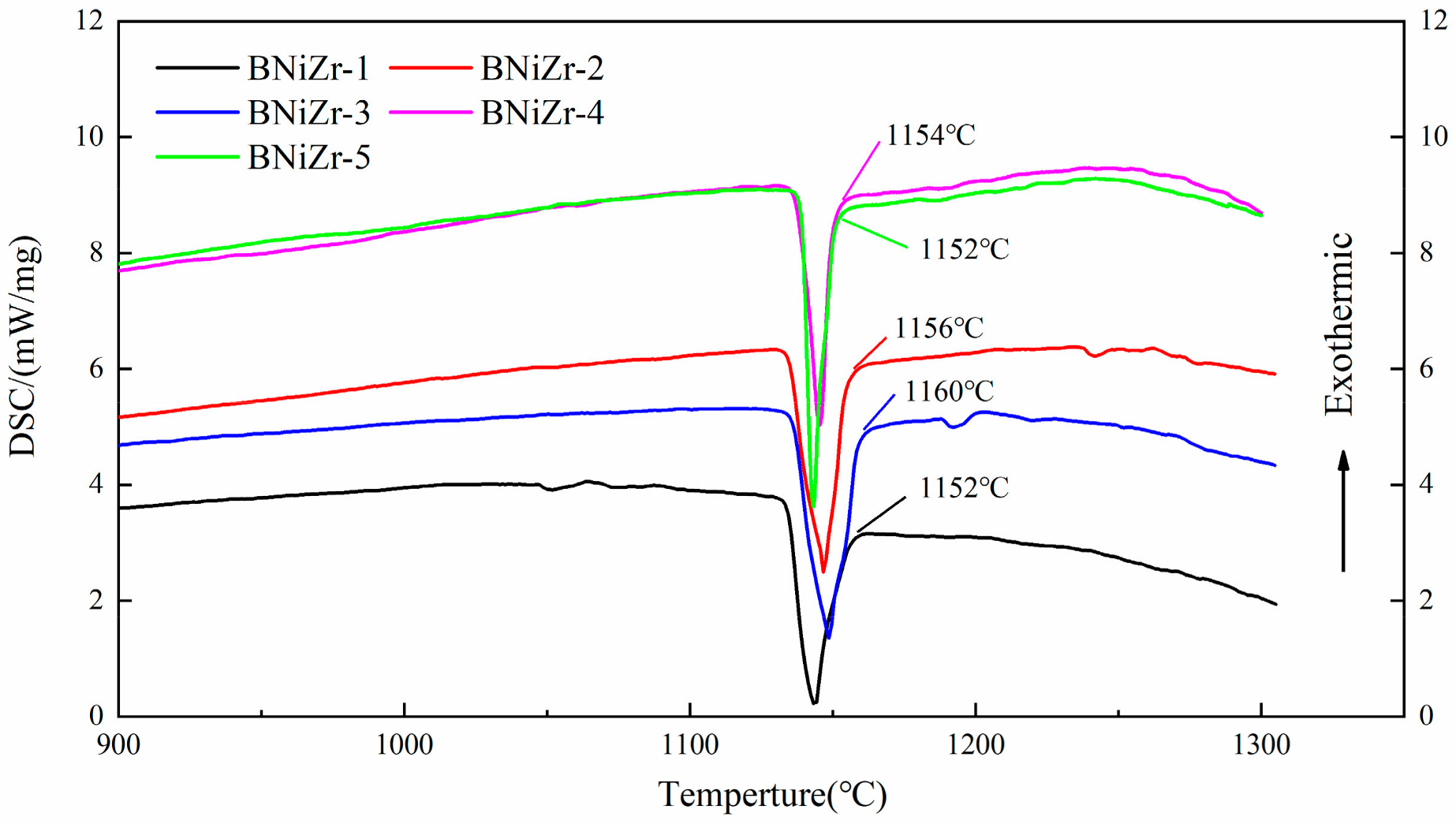

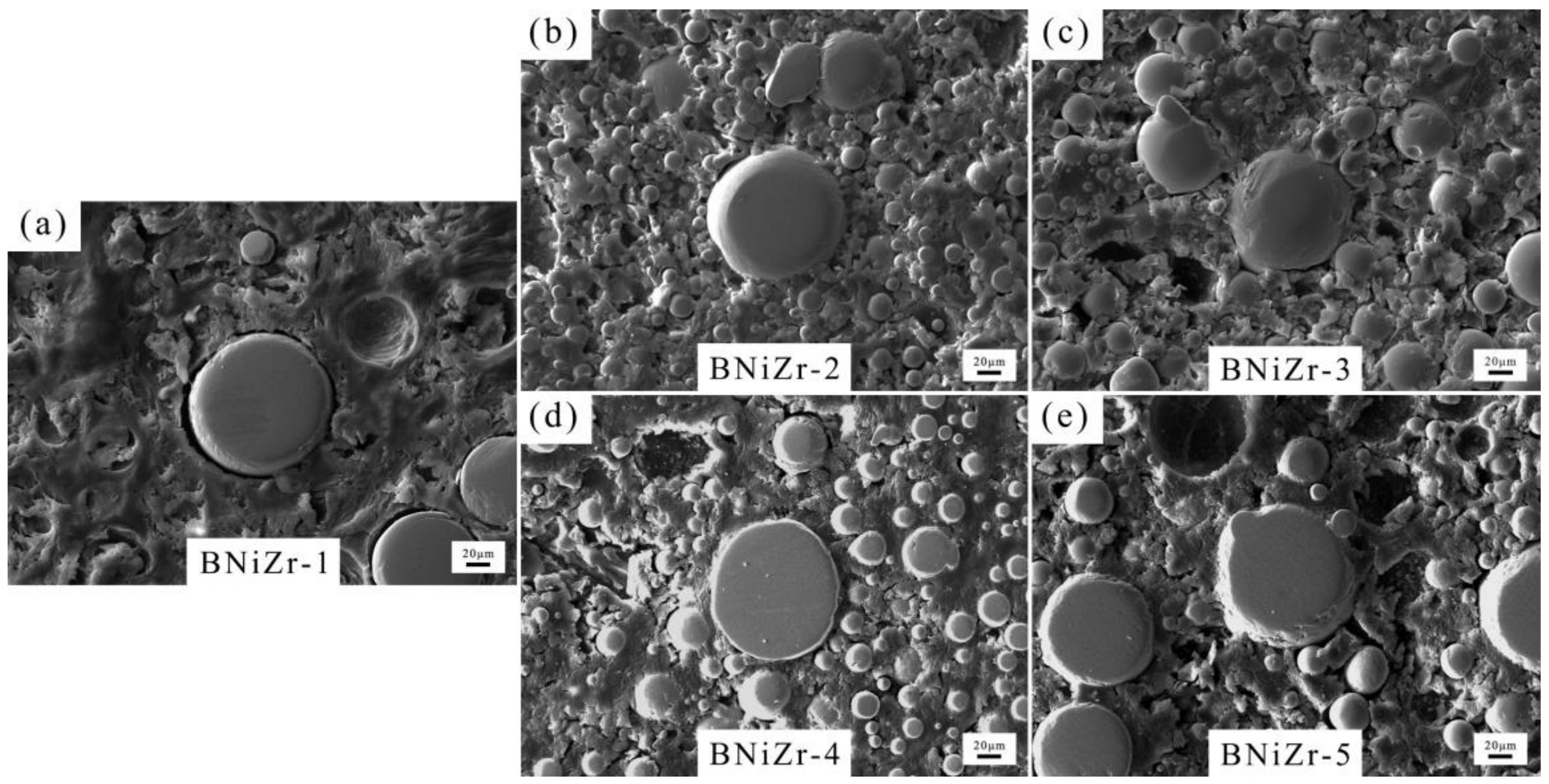

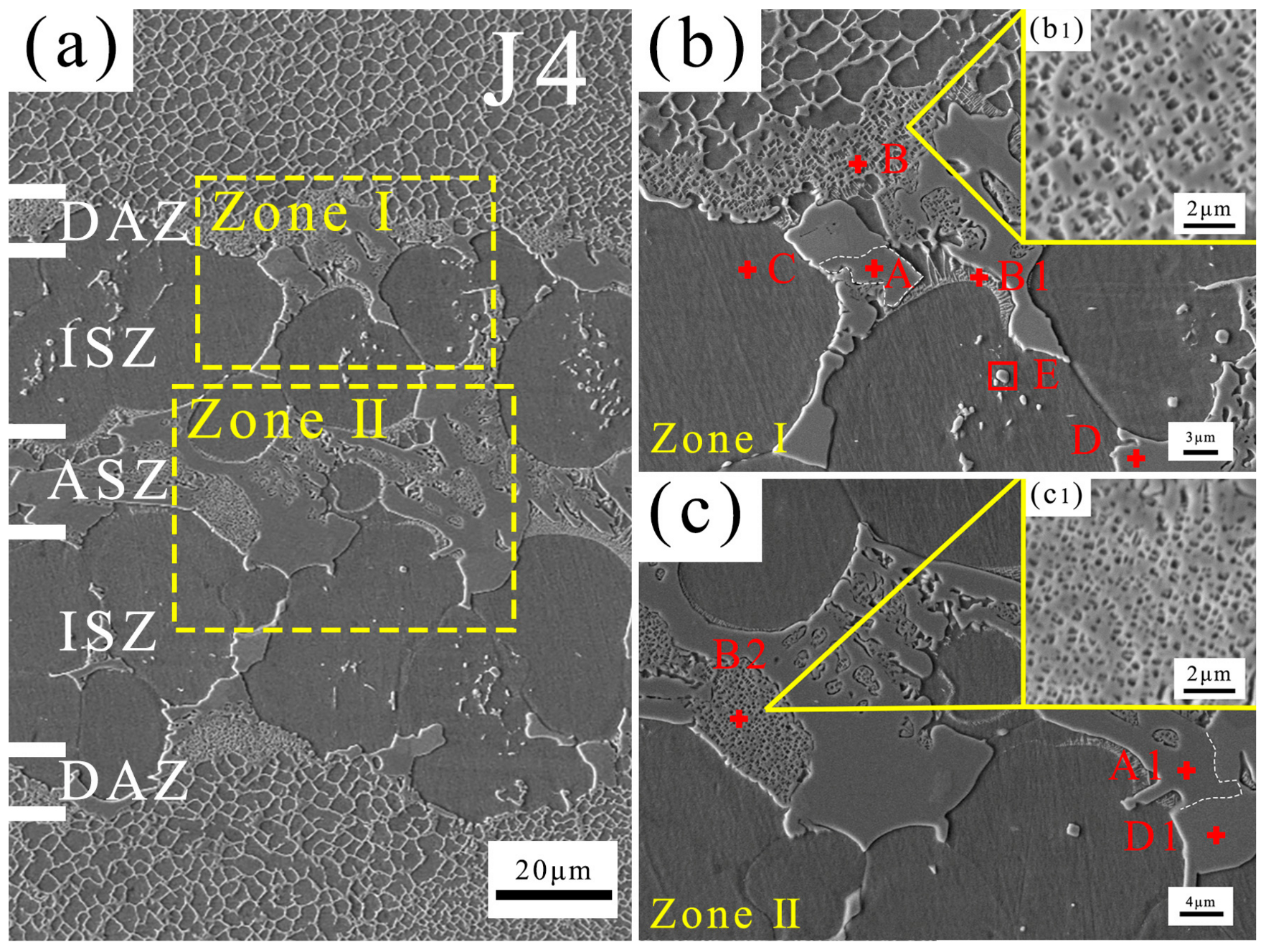
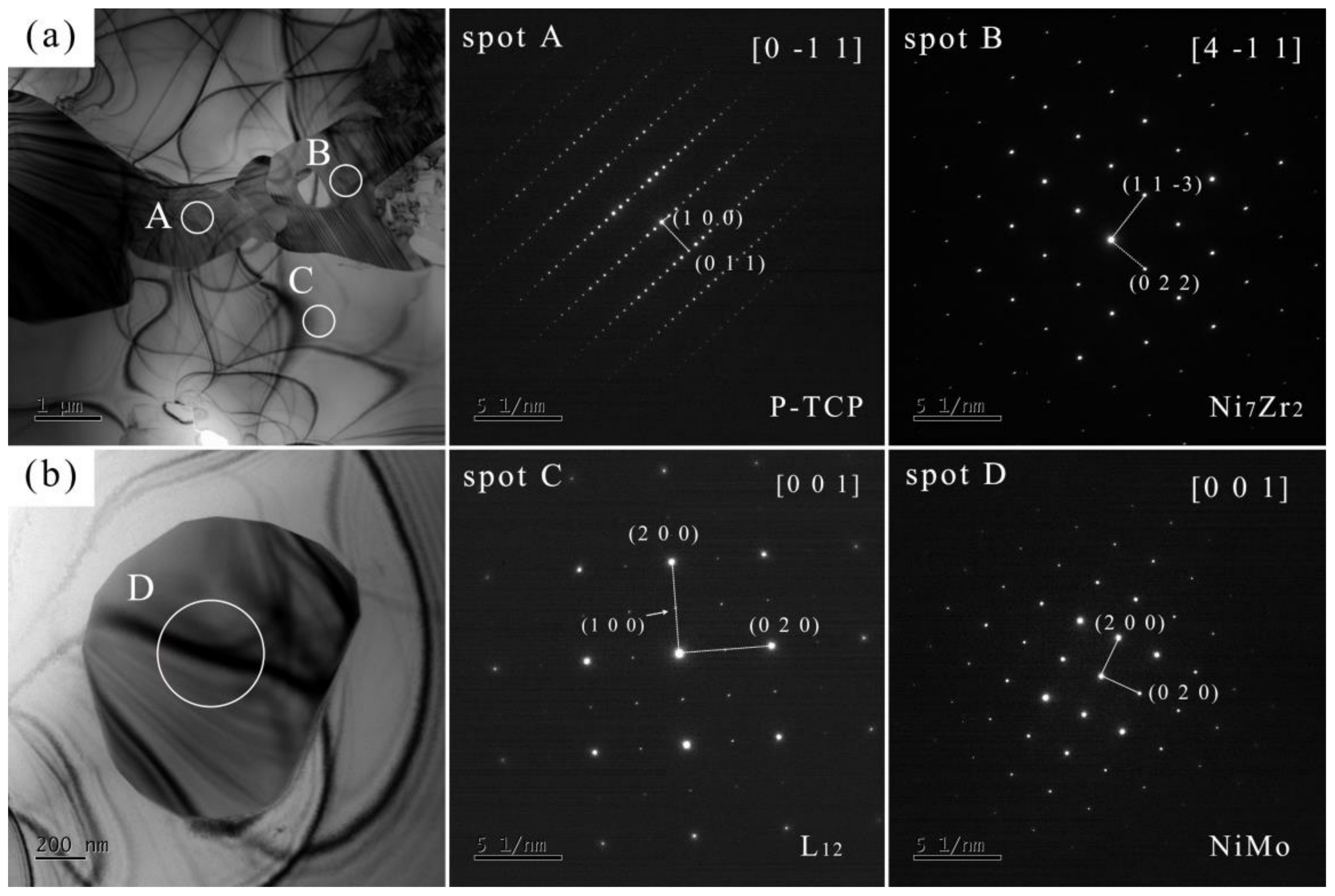
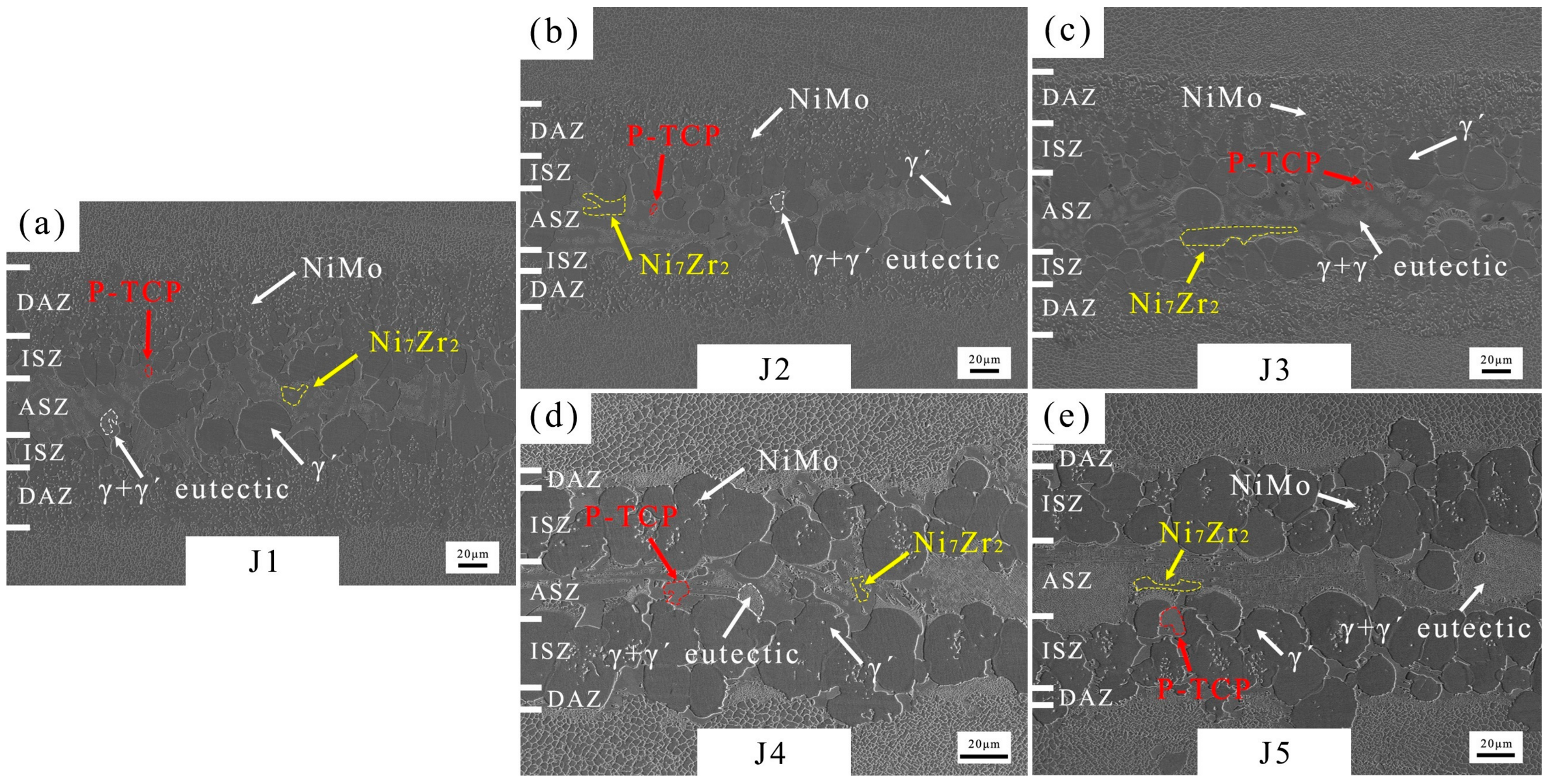
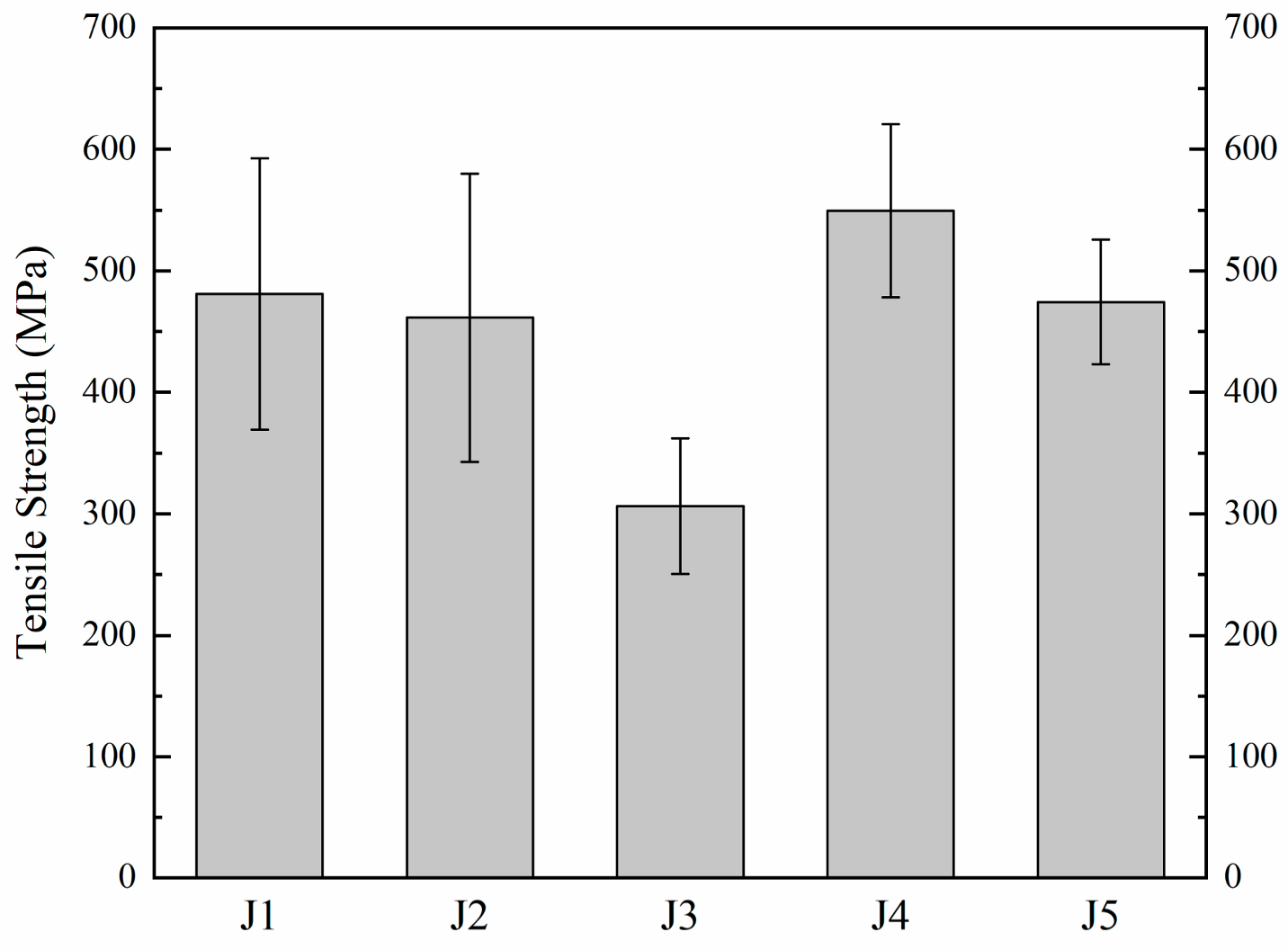
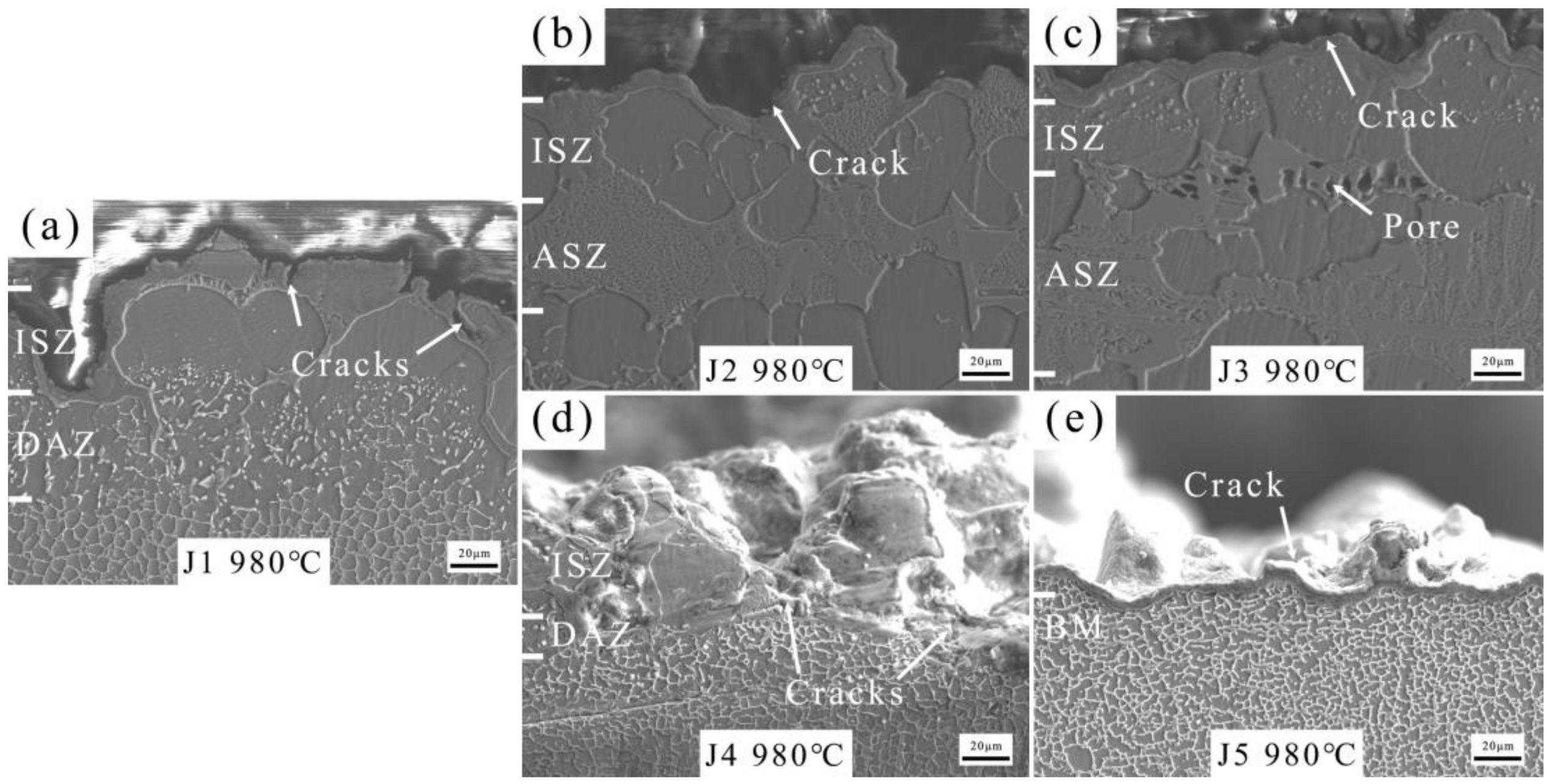

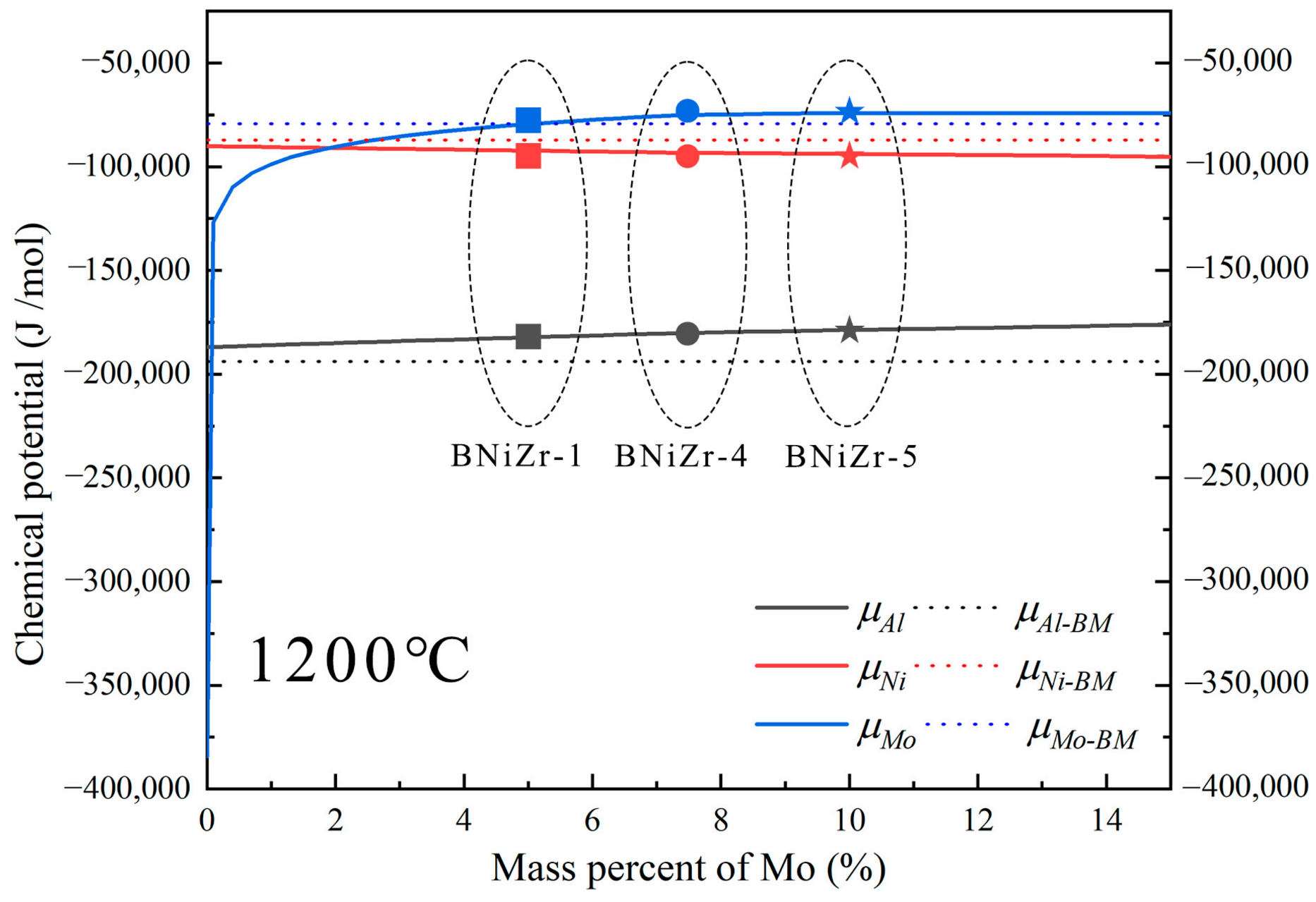
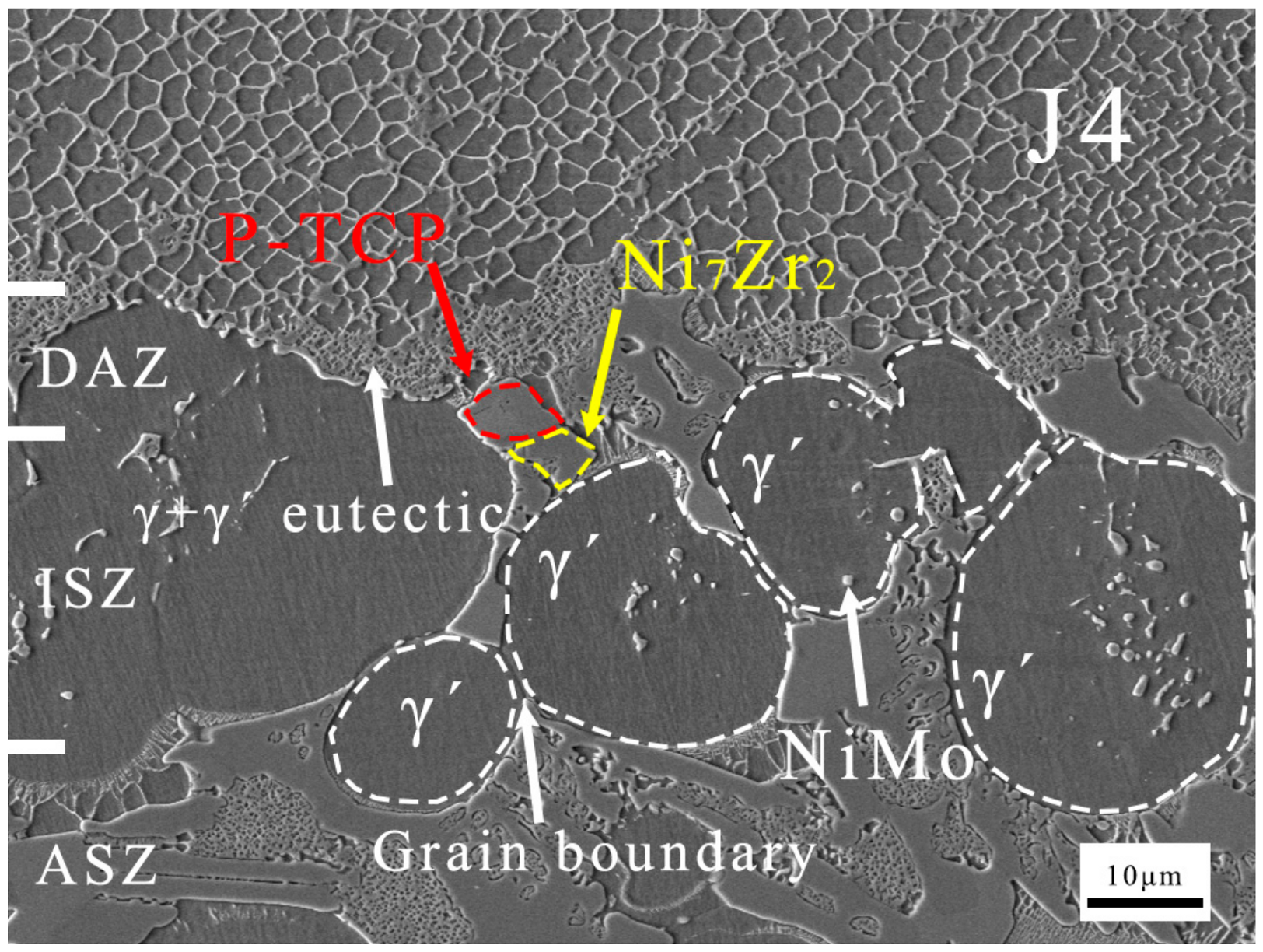



| Sample | Re | Mo | Al | Ta | Cr | Zr | Ni |
|---|---|---|---|---|---|---|---|
| BNiZr-1 | 4.8–5.2 | 7.0–7.8 | 2.8–3.2 | 4.7–5.3 | 11.8–12.2 | Bal. | |
| BNiZr-2 | 4.8–5.2 | 7.0–7.8 | 2.8–3.2 | 4.7–5.3 | 13.8–14.2 | Bal. | |
| BNiZr-3 | 4.8–5.2 | 7.0–7.8 | 2.8–3.2 | 4.7–5.3 | 15.8–16.2 | Bal. | |
| BNiZr-4 | 7.3–7.7 | 7.0–7.8 | 2.8–3.2 | 4.7–5.3 | 11.8–12.2 | Bal. | |
| BNiZr-5 | 9.8–10.2 | 7.0–7.8 | 2.8–3.2 | 4.7–5.3 | 11.8–12.2 | Bal. | |
| IC21 | 1.2–1.8 | 9.0–10.0 | 7.0–8.0 | 2.5–3.5 | 1.2–1.8 | Bal. |
| Spot | Re | Mo | Al | Ta | Cr | Zr | Ni | Phase Component | Zone |
|---|---|---|---|---|---|---|---|---|---|
| A | 0.00 | 1.41 | 2.08 | 0.19 | 1.16 | 20.09 | 75.08 | Ni7Zr2 | DAZ |
| B | 0.80 | 12.06 | 7.30 | 0.18 | 10.85 | 0.29 | 68.53 | γ+γ′ eutectic | DAZ |
| B1 | 0.23 | 4.64 | 14.04 | 0.21 | 4.64 | 2.48 | 73.95 | γ+γ′ eutectic | DAZ |
| D | 1.69 | 49.16 | 6.60 | 1.41 | 6.02 | 0.00 | 35.12 | P-TCP | DAZ |
| E | 5.59 | 32.84 | 3.61 | 0.27 | 10.68 | 0.38 | 46.61 | NiMo | DAZ |
| C | 0.00 | 2.62 | 18.28 | 1.12 | 2.35 | 1.35 | 74.27 | γ′ | ISZ |
| A1 | 0.00 | 1.17 | 2.39 | 0.20 | 1.23 | 20.52 | 74.49 | Ni7Zr2 | ASZ |
| B2 | 0.05 | 9.93 | 8.82 | 0.03 | 13.14 | 0.38 | 67.65 | γ+γ′ eutectic | ASZ |
| D1 | 1.56 | 48.62 | 6.60 | 1.14 | 6.65 | 0.17 | 35.26 | P-TCP | ASZ |
| Spot | Re | Mo | Al | Ta | Cr | Zr | Ni | Phase Component |
|---|---|---|---|---|---|---|---|---|
| A | 3.10 | 44.51 | 2.38 | 0.28 | 11.63 | 0.37 | 37.73 | P-TCP |
| B | 0.07 | 1.98 | 1.74 | 0.13 | 0.88 | 17.20 | 77.99 | Ni7Zr2 |
| C | 0.10 | 4.13 | 16.13 | 1.63 | 0.97 | 0.00 | 77.04 | γ′ |
| D | 2.47 | 51.29 | 7.08 | 1.17 | 5.5 | 0.51 | 31.97 | NiMo |
| Phases | Crystal Structure | Space Group | ) | α, β, γ |
|---|---|---|---|---|
| P-TCP | Orthorhombic | Pnma | a = 16.98; b = 4.75; c = 9.07 | 90°, 90°, 90° |
| Ni7Zr2 | Monoclinic | C2/m | a = 4.70; b = 8.24; c = 12.19 | 90°, 96°, 90° |
| γ′ | Cubic | Pmm | a = b = c = 3.52 | 90°, 90°, 90° |
| γ | Cubic | Fmm | a = b = c = 3.48 | 90°, 90°, 90° |
| NiMo | Orthorhombic | P212121 | a = b = 9.11, c = 8.85 | 90°, 90°, 90° |
| Phases | Interplanar Distance Calculated | Interplanar Distance Measured | ||
|---|---|---|---|---|
| P-TCP | ||||
| Ni7Zr2 | ||||
| γ′ | ||||
| NiMo | ||||
Disclaimer/Publisher’s Note: The statements, opinions and data contained in all publications are solely those of the individual author(s) and contributor(s) and not of MDPI and/or the editor(s). MDPI and/or the editor(s) disclaim responsibility for any injury to people or property resulting from any ideas, methods, instructions or products referred to in the content. |
© 2024 by the authors. Licensee MDPI, Basel, Switzerland. This article is an open access article distributed under the terms and conditions of the Creative Commons Attribution (CC BY) license (https://creativecommons.org/licenses/by/4.0/).
Share and Cite
Cao, Y.; Liu, Y.; Geng, L.; Song, Y.; Zhang, J.; Ji, T.; Ye, F.; Zhang, J.; Zhang, H.; Pei, Y.; et al. Study on Ni3Al-Based Single Crystal Superalloy Joints Brazed by Vacuum Brazing with Zr-Containing Filler. Crystals 2024, 14, 880. https://doi.org/10.3390/cryst14100880
Cao Y, Liu Y, Geng L, Song Y, Zhang J, Ji T, Ye F, Zhang J, Zhang H, Pei Y, et al. Study on Ni3Al-Based Single Crystal Superalloy Joints Brazed by Vacuum Brazing with Zr-Containing Filler. Crystals. 2024; 14(10):880. https://doi.org/10.3390/cryst14100880
Chicago/Turabian StyleCao, Yang, Yuan Liu, Lilun Geng, Yang Song, Jianqiang Zhang, Tianxu Ji, Fei Ye, Jie Zhang, Heng Zhang, Yanling Pei, and et al. 2024. "Study on Ni3Al-Based Single Crystal Superalloy Joints Brazed by Vacuum Brazing with Zr-Containing Filler" Crystals 14, no. 10: 880. https://doi.org/10.3390/cryst14100880
APA StyleCao, Y., Liu, Y., Geng, L., Song, Y., Zhang, J., Ji, T., Ye, F., Zhang, J., Zhang, H., Pei, Y., Li, S., & Gong, S. (2024). Study on Ni3Al-Based Single Crystal Superalloy Joints Brazed by Vacuum Brazing with Zr-Containing Filler. Crystals, 14(10), 880. https://doi.org/10.3390/cryst14100880






